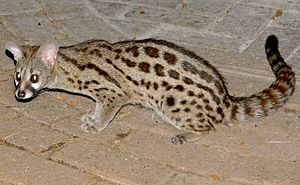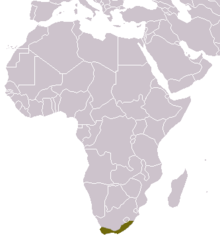Southern gorse cat
| Southern gorse cat | ||||||||||||
|---|---|---|---|---|---|---|---|---|---|---|---|---|

Genetta tigrina |
||||||||||||
| Systematics | ||||||||||||
|
||||||||||||
| Scientific name | ||||||||||||
| Genetta tigrina | ||||||||||||
| ( Schreber , 1776) |
The southern gorse ( Genetta tigrina ) lives in coastal regions in southern Africa ( South Africa and Lesotho ). The distribution area extends from the south of the Western Cape Province to the south of KwaZulu-Natal (east coast) and the bordering Lesotho. The species inhabits forests and heathlands in the fynbos and is not considered endangered.
features
The southern gorse cat has an elongated body with strikingly short legs and a long tail. The head-torso length is 46–58 cm in males and 42–56 cm in females. The tail length reaches up to 46 cm. Females weigh a maximum of 1.9 kg, males up to 2.1 kg. The upper side of the body is yellowish-white to gray in color, the underside gray to white-gray. A black stripe runs down the middle of the back. On the sides of the body, the stripes dissolve into a diminishing, dark pattern of spots. The tail has 7–8 light ringlets, which alternate with dark ringlets, the tip of the tail is black. The head tapers to the muzzle, the face is drawn like a mask. The claws can be retracted while climbing.
Distribution and habitats
The southern gorse cat is common in relatively rainy regions along the south and east coast of South Africa. The distribution area extends from the south of the Western Cape Province to the south of KwaZulu-Natal and the bordering Lesotho . The northern limit of the area is 32 ° S (further north, information on the location of the site can be attributed to Genetta maculata ).
The species lives in forests and in coastal and mountain fynbos (heaths in the floral region of Capensis ). The habitats are characterized by dense vegetation and a good water supply; more open areas are also sought out for hunting.
Way of life
The southern gorse cat is a nocturnal predator. It feeds mainly on small mammals , birds and arthropods such as insects . Small pets and poultry are also captured and rubbish ransacked near settlements. Southern gorse cats seem to be solitary outside of the breeding season. Lifestyle details are not known.
Danger
No significant hazards are known. Since its range is relatively large, it seems to be relatively common and can be found regularly in protected areas, the IUCN classifies the southern gorse cat as not endangered (least concern).
Web links
Individual evidence
- ↑ a b c d AP Jennings & G. Veron (2009): Family Viverridae. In: DE Wilson. & RA Mittermeier (Eds.) Handbook of the Mammals of the World. Volume 1: Carnivores. Lynx Edicions, Barcelona.
- ↑ G. Mills & L. Hes (1999): Mammals of Southern Africa. An illustrated encyclopedia. - Könemann, ISBN 3-8290-3610-8 .
- ↑ a b c Genetta tigrina in the Red List of Threatened Species of the IUCN 2011. Posted by: P. Gaubert & M. Hoffmann, 2008. Accessed July 22, 2011.
